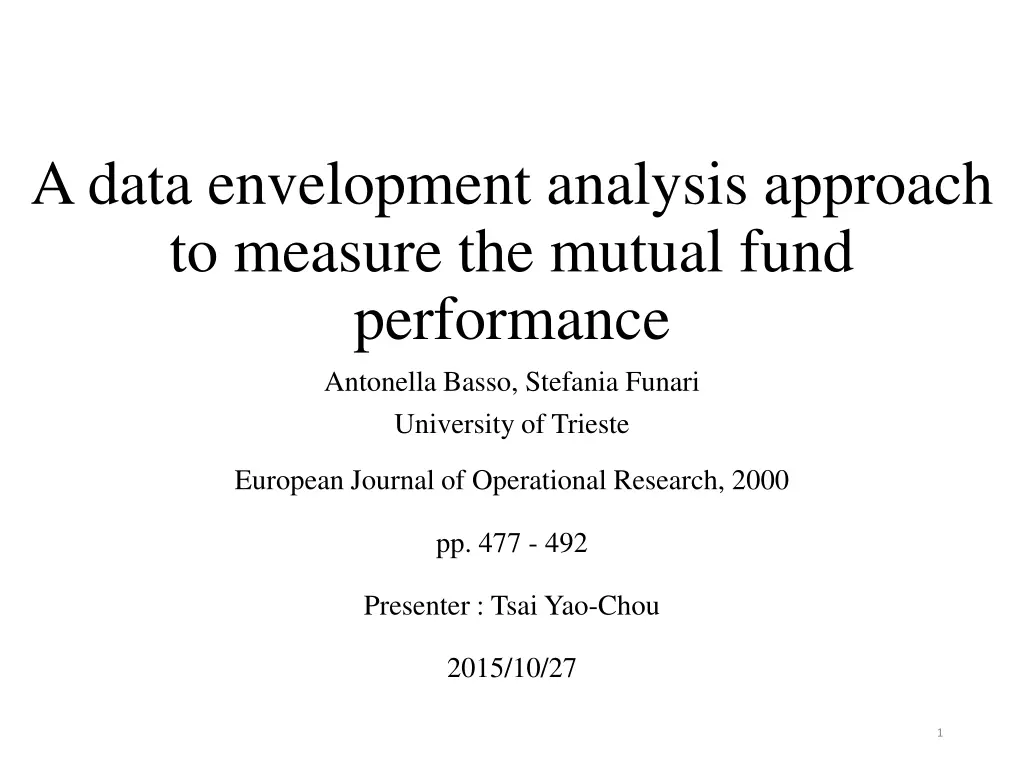
Data Envelopment Analysis Approach for Mutual Fund Performance Evaluation
Explore a study on measuring mutual fund performance using Data Envelopment Analysis (DEA). The model allows for evaluating relative efficiency, considering various inputs, risk measures, and investment costs. It also introduces a generalized DEA mutual fund performance index incorporating stochastic dominance indicators.
Download Presentation

Please find below an Image/Link to download the presentation.
The content on the website is provided AS IS for your information and personal use only. It may not be sold, licensed, or shared on other websites without obtaining consent from the author. If you encounter any issues during the download, it is possible that the publisher has removed the file from their server.
You are allowed to download the files provided on this website for personal or commercial use, subject to the condition that they are used lawfully. All files are the property of their respective owners.
The content on the website is provided AS IS for your information and personal use only. It may not be sold, licensed, or shared on other websites without obtaining consent from the author.
E N D
Presentation Transcript
A data envelopment analysis approach to measure the mutual fund performance Antonella Basso, Stefania Funari University of Trieste European Journal of Operational Research, 2000 pp. 477 - 492 Presenter : Tsai Yao-Chou 2015/10/27 1
Abstract(1/2) In this paper we present a model which can be used to evaluate the performance of mutual funds. This model applies an operational research methodology, called data envelopment analysis DEA), which allows to measure the relative efficiency of decision making units. This approach allows to define mutual fund performance indexes that can take into account several inputs and thus consider different risk measures and, above all, the investment costs subscription costs and redemption fees). Moreover, the DEA approach can naturally envisage other output indicators, in addition to the mean return considered by the traditional indexes. Therefore, a generalized version of the DEA mutual fund performance indexes is defined, too, which includes among the outputs a stochastic dominance indicator that reflects both the investors' preference structure and the time occurrence of the returns. 2
Abstract(2/2) In addition, the procedure allows to identify, for each mutual fund, a composite portfolio which can be considered as a particular benchmark. The performance indexes proposed are tested on empirical data. 3
Data Envelopment Analysis 1. : 2. : 3. : Charnes et al., 1978 4. : ? 0???? ? ????? ? = Y: Output, X: Input, u and v: (weight) 4
Data Envelopment Analysis(1/2) Input Output (?1) (?2) (?1) 40 55 150 (?2) 30 65 130 A B C 50 75 100 60 95 120 C : ??????? A : ??????? B : ??????? (?1 150+?2 130) (?1 100+?2 120) (?1 40+?2 30) (?1 50+?2 60) (?1 55+?2 65) (?1 75+?2 95) Subject to (?1 40 + ?2 30) (?1 50 + ?2 60) 1, ?1 55 + ?2 65 ?1 75 + ?2 95 ?1 150 + ?2 130 ?1 100 + ?2 120 1, 1 ?1,?2,?1,?2 0 5
Data Envelopment Analysis(2/2) Conclusion: 1. ( ) 2. Input( ) 3. Model 4. 6
#1 DEA Model(1/4) ? ??0 ??? ? ?=1 ?? ???0+ ?=1 ?? ???0 Subject to ? ??0 1,j = 1, ,n ? ?=1 ?? ???0+ ?=1 ?? ???0 ? ? ?? ?,? = 1, , ?? ?,? = 1, ,? ?: Small positive number, prevent the weight from vanish. 7
#1 DEA Model(2/4) ? ??0 ? ?=1 ?? ???0+ ?=1 ?? ???0 1. n mutual funds, ? = 1,2, ,? 2. ??0: The expected return ? ?? ? of fund 0. ( ) ? is the riskless rate of return. 3. ?: risk, 1 to h( ) 4. ?: subscription and redemption costs, 1 to k ( ) 8
#1 DEA Model(3/4) Definitions: ?(??): Expected return( ), . ? ? = (????) ?=1 A B 0.3 90% 20% 0.4 15% 15% 0.3 -60% 10% A: ? = 0.3 90% + 0.4 15% + 0.3 60% = 15% B: ? = 0.3 20% + 0.4 15% + 0.3 10% = 15% 9
#1 DEA Model(4/4) ??: ? R?= ?? ?? ?=1 ??: j portfolio ?: portfolio Risk: 1. ? = ???(??) ?? = ?(??? ?? ? ??,0 )2(half-variance) 2. ???(??,??) ???(??) 3. ??= ??: Market portfolio( ), Sharpe ratio 10
Stochastic dominance(1/2) Make an order of portfolios. Two Gambles A & B, outcome x, ? ? ? ? ? ? . Example: Gamble/State 1 2 3 4 5 6 Gamble A wins 1 1 2 2 2 2 Gamble B wins 1 1 1 2 2 2 Gamble C wins 3 3 3 1 1 1 Utility function: ( ) Trivial Example: 2 products tea & coffee. ? ?,? = ? + ? Buy 1 tea and 0 coffee: ? ?,? = 0 + 1 = 1 11
Stochastic dominance(2/2) Two portfolios, X and. Y A utility function set: ??= ???? 1: 1??? 0 ? ? ? ? ? ? ? ?? 12
#2 DEA Model ?1 ??0+ ?2 ??0 ?? ???0+ ?=1 ??? ? ?=1 ?? ???0 ??= ? fund ????????? ????????? P????? Subject to ?1 ??0+ ?2 ??0 ?? ???0+ ?=1 ?? ???0 1, j=1, ,n ? ?=1 ur ?,r=1,2 vi ?,i=1,...,h wi ?,i=1, ,k 13
